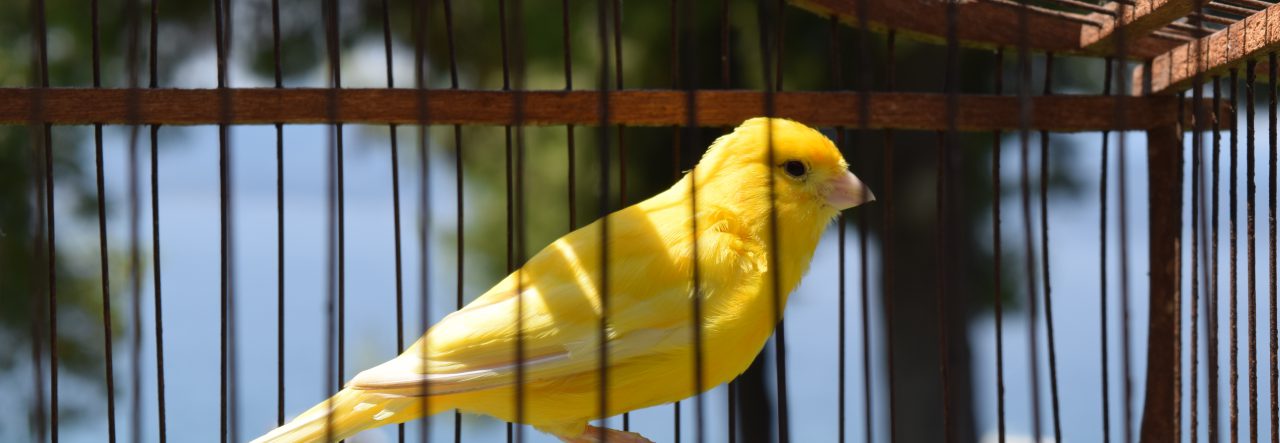Διάβασέ το στα Ελληνικά εδώ
The canary is a singing bird that belongs to the family of Fringillidae (Fringillidae). The official name of the domesticated canary is sirinus canaria domesticus.

History
Canaries were introduced to Spain in the 15th century after the conquest of the Canary Islands by the Spaniards. Due to a maritime accident, a large canary load has escaped and soon spread across Europe. Also the canary is likely to come from the wild canary (Serinus canaria canaria), which originates from the Canary Islands of Madeira, the Azores, Tenerife and others.

Varieties
Common Canary
Canaries are divided into three major categories:
The Dutch canaries. They are big, they have soft plumage, but they are not distinguished for their singing.
German canaries. They have nice color and nice voice.
English canaries. They have a dark yellow color that changes in yellowish-red or red-orange due to the artificial diet of pepper, sugar, flour and boiled egg.
Some countries breed canaries for their singing while others for their color. There are different types of canaries grouped into separate categories according to their specific characteristics. Thus, they are categorized according to their different motifs, their different coloring and their different external appearance, with or without wrinkles or curls. These include the wild canary. It has a green plumage with gray streaks and yellow hues on the head and on the back. It can easily mate with the goldfinch. In the eastern Mediterranean lived another species of canary, the domesticated, which originated from the wild canary and had begun to enter Europe in the late 16th century. The various canary species present today are derived from crossings and mutations from breeders. In Malin, the inhabitants of the area have a melodic canary malina, with metallic notes, medium and high, as well as water-jet and unreadable. In England they cross old canary tribes and create new big canaries that take their name from the homonymous cities where they were created. In France the curly canary from Paris, Belgium the typical Canary Canary and many more in different countries and regions. Named for their chirping is the Canaries of Hart.
Characteristics – behavior
Canaries are clean, calm and do not need special care; they do not like to touch them. The melodic and pleasant sound they make when singing is their special feature. It is also their most sensitive and powerful point, since if they get sick they stop singing until next spring. From the early months of their lives, especially males, they start to sing. Canaries have learned to live in the cage and are therefore not known as social birds. Their life is pleasant inside the cage. For better survival of canaries, males should be in separate cages from females to avoid collisions. But in order to have a companion, the cages are good to be in close proximity.
Reproduction
It is not easy to distinguish the sex of canaries. During the breeding season, however, we can distinguish it more easily from behavior. At that time, usually in the spring, males are particularly talkative. Canaries are relatively easy to breed at home as long as:
be healthy and adult
there is plenty of water and food
a nest and materials to place in the nest.
To prevent injuries to the female, the couple must stay together in the same cage only at that time. The female generates 3-5 eggs, incubating for about 14 days before hatching, while the newborns are born without plumage and are ready to leave the nest in about a month. Canaries are raised by both parents. Once a year at the end of the breeding season, canaries are changing their plumage.
Food and cage
The main canary food is a variety of mixed seeds. However, when feathers change, they need supplements rich in protein, such as egg, chopped chicken or powdery mildew. The type of red canaries should be supplemented with melted carrots, sweet potatoes or carotene. If there is a constant source of stress in the life of a canary, such as fear, competition with other canaries in the cage, infection or bad design of the cage, the wings are not properly formed and can be left without plumage all year round. When the weather is cold, the canaries must stay in the house, where there is no air flow. The crate must be spacious, safe and have many branches. Canaries can live if they are taken care of by their owner for up to 14 years.

Pingback: The oranges and the great benefits for the birds and canaries – mbirdTraining
Hello
I like your birds I got a canary couple last summer 2020 he said male and female anyway, the female flew just one month later I forgot to close the cage just in second the cage was in the balcony
please any help my canary has always liquid or like water stool I give him vegies and canary seed
any advices online is not helpful.
Thank you much and have a great time
By the way every day I play your canary song and now my bird is singing the same
Khadija from Canada
LikeLike
I really like canary birds they are very happy
LikeLike
I really like canary birds they are very happy.
LikeLike